2. 浙江农林大学环境与资源学院, 杭州 311300;
3. 浙江大学土水资源与环境研究所, 杭州 310058
2. College of Environmental and Resource Sciences, Zhejiang A & F University, Hangzhou 311300, China;
3. Institute of Soil and Water Resources and Environmental Science, College of Environmental and Resource Sciences, Zhejiang University, Hangzhou 310058, China
微生物入侵指外源性微生物经自然或人为途径进入到新生态系统,通过竞争、协同等作用对侵入地的群落组成、结构及功能产生效应的过程[1]。有害微生物入侵土壤造成土壤生态系统的组成结构以及功能的失衡,形成微生物污染。土壤生态系统组成多样,功能复杂,其健康因子主要包括酸碱度、有机质、碳氮磷以及微生物等,其中微生物作为影响土壤健康的关键因子,可参与有机质分解、土壤结构和耕性改善、矿物质分解及固氮等过程,是土壤物质转化和能量流动的核心驱动力[2]。经济社会的快速发展以及人类活动的日益频繁,为外源生物的传播创造了良好的前提条件。微生物正随着水体、动植物迁移以及经济贸易等方式以前所未有的规模在全球范围内进行传递,其中包括细菌克隆体与抗性基因在全球陆地环境间的快速传播[3]。
外源微生物进入土壤生态系统可对土著微生物群落结构与功能产生影响[4],主要包括以下两个方面:(i)积极影响:主要指有益微生物入侵,如人为添加外源根际促生菌,可促进植物生长,修复土壤污染,降低土传病害发生率等,例如人为将固氮螺菌(Azospirillum)大量投入土壤中可显著提高植物固氮能力、植物激素活性以及防控病虫害等[5];解钾菌、溶磷菌与苍白杆菌组成的植物根际促生混合菌剂可显著提高蒲儿根在铜污染土壤中的抗逆性和对铜的富集能力[6];多黏类芽孢杆菌(Paenibacillus polymyxa)可通过降解尖孢镰刀菌毒素以减轻黄瓜枯萎病病害程度[7]。(ii)消极影响:主要指有害微生物入侵,如沙门氏菌(Salmonella)、尖孢镰刀菌(Fusarium oxysporum)、致病性大肠杆菌(Enteropathogenic Escherichia coli)等,可显著改变土著微生物群落结构与功能,造成农作物病害,降低农产品产量。此类病原微生物可通过土壤、水、空气、食物等途径进入人体,对人类健康产生威胁[8]。例如1996年日本爆发的大肠杆菌O157:H7疫情导致44个都府县受到污染[9];美国于2009年由于番茄受到种植土壤中沙门氏菌污染后造成人群沙门氏菌疫情爆发等[10];湖北省武汉市于2019年末发生的新冠肺炎病毒传染事件对人群健康以及社会经济造成了极大的影响。早期监控追踪技术相对落后,对微生物入侵关注度较低,随着现代科技手段的不断发展,开展微生物入侵相关的研究结果对防控土传病害、提高土壤生产力、保护人类健康具有重要的科学意义和实际价值。
目前,关于土壤生态系统的“微生物入侵”相关内容的计量整合分析还十分有限,本文基于Web of Science(WoS)核心数据库,结合CiteSpace、VOSviewer等软件,对国内外近20年内(2000年—2021年)微生物入侵土壤生态系统的发文数量、主要国家及研究机构、研究学者、学科门类以及关键词聚类等内容进行计量分析,重点关注土壤学领域微生物入侵的研究热点,全面了解外源微生物入侵对植物-土壤生态体系的影响,旨在为培育健康土壤和保障作物安全提供理论支撑。
1 材料与方法 1.1 数据来源本文分析论文数据库检索源为Web of Science核心合集数据库,根据研究目标,以“soil” AND “invasive” OR “invasion” AND “soil microbial” OR “soil pathogen” OR “soil microbe” OR “soil borne disease”等关键词进行检索,时间设置为2000年—2021年,筛选数据类型为“article”,检索文献截止日期设置为2021年6月9号,最终检索结果为23 333篇。选择筛选得到的所有文献数据,导出为纯文本格式,保存于“input”文件夹。在CiteSpace中点击Data— > Import/Export,进入CiteSpace功能界面,并在菜单中选择数据的预处理菜单,进入数据预处理功能界面。选择工作文件夹为“input”和“output”,数据加载结束后,点击“Remove duplicates(WoS)”执行去重过程,得到的文件即为后续分析数据源。
1.2 研究方法利用Web of Science自带分析检索结果功能,对2000年—2021年间发表的23 333篇文献进行发文国家/地区、学科的计量分析,采用Excel 2013(Microsoft Corporation,Redmond,WA,USA)与Origin 2019软件进行统计图计算与绘制;利用CiteSpace分析数据源文献得到关键词突现信息(Burstness)并计算关键文献中心度;采用VOSviewer的Co-authorship功能分析发文国家与机构之间合作紧密程度,阈值均设置为50;通过共现分析(Co-occurence),将阈值设置为100,选定所有关键词(All Keywords)选项统计出现频率较多的关键词,反映该领域的研究热点;Co-citation分析近二十年来被引频次最高,影响最大的文献;利用HistCite运算期刊本地引用及总引用。
2 结果与讨论 2.1 文献产出趋势Web of Science核心数据库检索数据达23 333篇,核心数据库检索分析表明发文学科主要集中在植物科学、微生物学、环境科学与土壤学等,在检索文献时间范围内,植物科学比重最大为17.76%,其次为环境科学(15.21%)、微生物学(14.53%)、生态学(10.78%)、土壤科学(10.73%)等学科(图 1a)。目前微生物入侵研究热点主要集中于有益微生物的植物促生与病害防治功能[11]以及病原微生物入侵对植物与土壤造成生物污染[12]等方面,因此植物科学成为微生物入侵研究领域文章发表的主要学科。如图 1b所示,微生物入侵相关研究的发文数量逐年增加,发文数量最多的国家为美国,其次为中国,且该领域逐渐出现了多角度的研究:包括探究外源微生物入侵的影响因子、微生物入侵的阶段划分、微生物入侵的干扰效应等。
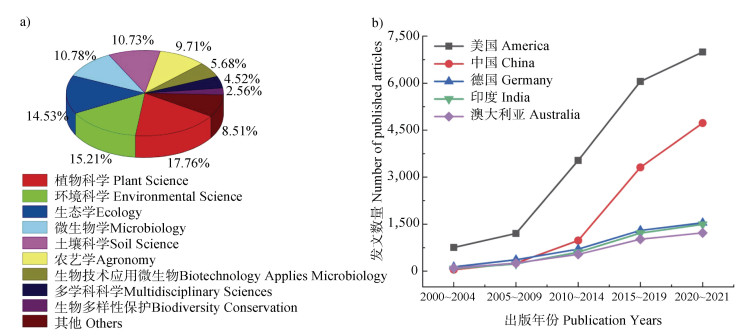
|
图 1 近二十年前十发文学科占比(a)及文献发表趋势(b)图 Fig. 1 The proportion of the top 10 published disciplines in the past 20 years (a) and the trend chart of literature publication (b) |
产出量位列前十的期刊及其2021年影响因子如表 1所示,发表论文较多的学术期刊包括Soil Biology & Biochemistry(770篇)、Frontiers in Microbiology(521篇)、PLoS One(489篇)、Plant and Soil(441篇)、Applied Soil Ecology(421篇)等,其中2021年单年影响因子大于5的学术期刊有Soil Biology & Biochemistry、Frontiers in Microbiology、Science of the Total Environment等。其中,研究领域的发文学科划分是根据23 333篇文献进行综合分析的结果,而关键期刊仅展示了排名靠前的部分期刊,可分别展示出该研究领域的重点学科与主要期刊。结果表明本地引用次数(TLCS)、总引用(TGCS)次数较高的期刊有Soil Biology & Biochemistry、Plant and Soil、Applied Soil Ecology、Applied and Environmental Microbiology等,论文产出量前十期刊中大多数被归类至土壤科学学科(1 191篇)、植物科学学科(1 148篇)及微生物学学科(902篇),结果显示该研究领域土壤科学学科总发文量低于其他学科,但该学科代表性期刊的发文量最高,表明微生物入侵相关研究一直是土壤科学学者的研究重点。
|
|
表 1 2000年—2021年微生物入侵研究领域研究发文量排名TOP10期刊 Table 1 Top10 journals in the field of microbial invasion research published articles during 2000—2021 |
在合作网络分析中,圆圈大小表征相应国家或机构发文情况,各圆圈之间连线表征个体之间的联系,连线愈密集合作关系愈强,圆圈越大表明发文数量越多。在所搜集2000年—2021年的文献中,中国科学院发文数量最多,其中南京农业大学与其他机构合作最为密切(图 2)。此外,本文对论文产出国进行了网络分析,结果显示发文国家中美国与其他国家之间联系最为密切,其次为中国、德国、印度等,与中国合作较为密切的国家/地区主要有印度、澳大利亚、巴基斯坦、马来西亚等国(图 3)。
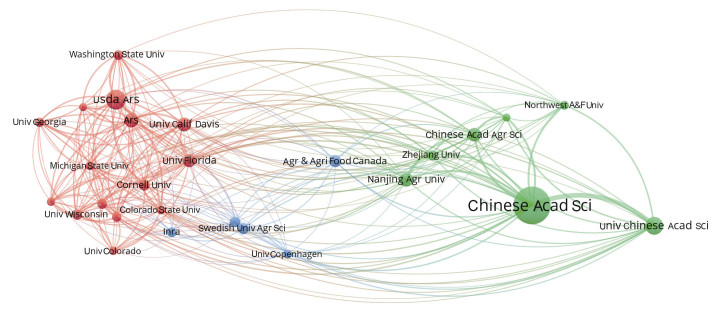
|
图 2 论文产出机构之间合作分析 Fig. 2 Analysis of cooperation between paper producing institutions |
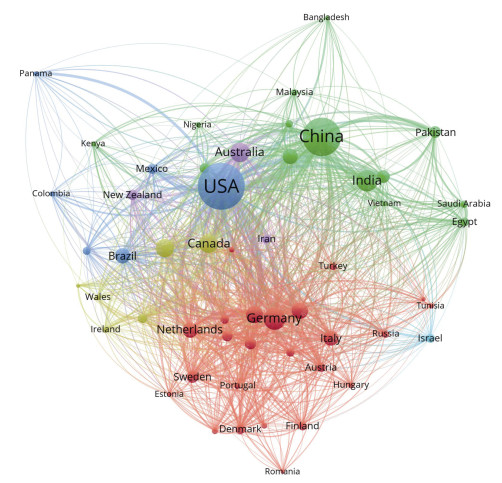
|
图 3 论文产出国家之间合作网络分析 Fig. 3 The paper analyses the cooperation network between countries |
对外源微生物入侵领域进行文献共被引分析,其中心性最大的文献为Lugtenberg和Kamilova发表的“Plant-growth-promoting Rhizobacteria”,以及Stinson发表的“Invasive Plant Suppresses the Growth of Native Tree Seedlings by Disrupting Belowground Mutualisms”(图 4)。关键文献基本信息如表 2所示,中心度是建立起2个不相关节点之间关系的桥梁,其中“Plant-growth-promoting Rhizobacteria”中心度最高为0.09,凸显出该节点的位置重要性,其中与植物相关的有益菌、病原菌研究在2000年—2021年的中心性值排名前十的文献中占据近80%的比例,表明现阶段学者的研究热点主要集中于有益菌及病原菌入侵植物-土壤体系的效应。Lugtenberg和Kamilova[13]于Annual Reviewer of Microbiology上发表的“Plant-growth-promoting Rhizobacteria”文章,主要归纳介绍了植物根际促生菌的定义、种类以及其直接与间接促生作用,并展望了植物根际促生菌在未来可持续农业上的应用;Stinson等[14]发表于PLoS Biology上的“Invasive Plant Suppresses the Growth of Native Tree Seedlings by Disrupting Belowground Mutualisms”文章,主要介绍了入侵植物大蒜芥菜(Alliaria petiolata)可通过改变土壤中菌根真菌与植物的互作机制进而抑制本土树种的健康生长;Lundberg等[15]发表在Nature上的“Defining the Core Arabidopsis Thaliana Root Microbiome”主要阐明了拟南芥核心根际细菌菌群与内生菌菌群的互作与寄主、土壤类型显著相关,可知稳定的微生物区系在受到外源微生物扰动时对植物-土壤微生物互作可造成显著影响;其他文献主要关注于根际细菌与植物健康的作用机理、地上菌群与地下菌群的生态功能等[16-17],揭示了微生物群落的稳定性与植物-土壤体系的生态功能息息相关。
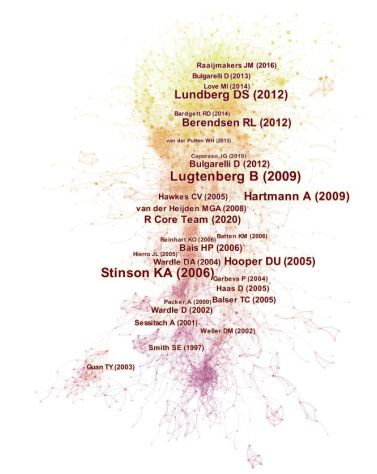
|
图 4 文献共被引分析 Fig. 4 Co-citation analysis |
|
|
表 2 关键文献基本信息 Table 2 Basic information of key literature |
基于VOSviewer可视化软件对文献的关键词进行共现分析,该领域的研究热点分析结果如图 5所示。计量软件将文献聚为三类,外源微生物入侵领域的关键词研究热点主要围绕Soil(土壤)、Diversity(多样性)、Growth(生长)等展开,可知当前研究主要关注3个方面:入侵微生物与土著微生物群落的互作(Cluster 1)、土壤微生物入侵机制与影响因子(Cluster 2)、土壤微生物入侵对植物(作物)表型的影响及病害防控机制(Cluster 3)。此外,本文运用关键词突现分析(Burst Detection)表征2000年—2021年关键词引用量的变化,表 3表明近年来关注度较高的关键词主要有Rhizosphere Microbiome(根际微生物组)、High-throughput Sequencing(高通量测序)、Metagenomics(宏基因组学)等,突现强度分别为17.82、17.40、16.80,这些关键词在一定程度上揭示了该领域当下的研究热点。
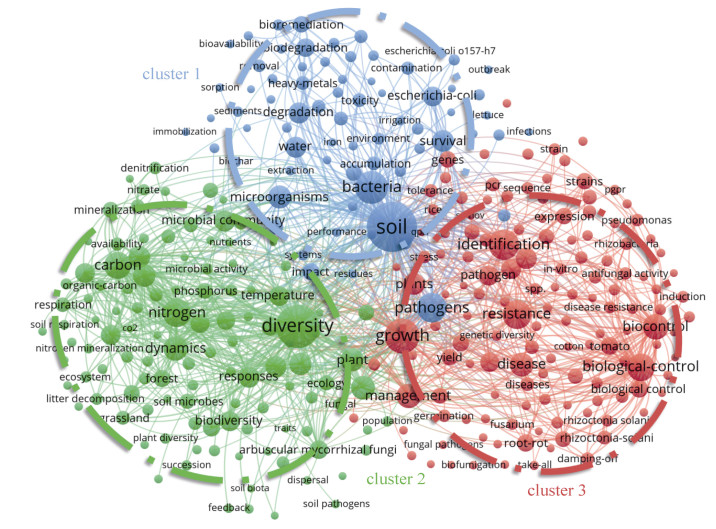
|
图 5 关键词共现网络分析 Fig. 5 Keywords co-occurrence network analysis |
|
|
表 3 关键词突现信息 Table 3 Information of Keywords with the citation bursts |
入侵微生物与土著微生物群落的互作(Cluster 1)包括的主要关键词有:Soil(土壤)、Bacteria(细菌)、Survival(存活)、Biodegradation(生物降解)、Bioremediation(生物修复)等。外源微生物经自然或人为途径进入到新生态系统后,与土著微生物群落互相影响,主要包括入侵微生物的存活以及土著菌群的结构与功能改变等。土壤生态系统中微生物种类繁多,组成复杂,不同微生物之间存在着错综复杂的相互作用关系,包括竞争、协同、共生、寄生等,由此可衍生出多样的群体行为[18]。微生物入侵效应包括对土著微生物群落结构、组成及功能的影响,主要体现在群落多样性以及各类菌群的动态变化上[19]。相关研究表明,将病原性大肠杆菌O157:H7污染的生活用水用于农田灌溉,其对土壤微生物群落的影响与土壤类型显著相关,如菌株入侵后可造成砂质土壤的群落多样性指数迅速上升而后趋于平稳,而黏土的群落多样性指数前期无显著差异,后期迅速上升[20]。Wei等[21]指出青枯菌入侵土壤后与土著菌群产生资源竞争、生态位重叠,由此改变了微生物群落的结构特征。此外,外源微生物在土壤体系中凋亡后依旧可改变土著群落的丰度及组成,并显著提高群落生态位及多样性指数等[22]。土著群落的多样性及结构对群落功能的稳定性起着至关重要的作用,多样性越低的群落受到外源微生物入侵后的群落功能变化越大[23]。此外,土壤微生物群落在受到足够强的外来干扰或原群落系统具有较低的抵抗力和恢复力,其转向另一种平衡状态继而成为一种新体系的可能性则大大提高[24-25]。恢复力越强的生态系统具有更强的资源利用能力,即环境因素和生态系统自身属性决定了群落的恢复能力[26]。因此,更为健康、优越的土壤环境对外源微生物入侵具有更强的抵抗力和恢复力。
2.4.2 土壤微生物入侵机制与影响因子土壤微生物入侵机制与影响因子(Cluster 2)包括的主要关键词有:Diversity(多样性)、Carbon(碳)、Nitrogen(氮)、Responses(响应)、Temperature(温度)等。外源微生物入侵过程划分为四个阶段:引入(Introduction)、种群建立(Establishment)、增长和传播(Growth and Spread)以及影响(Impact(s)),其中外源微生物进入新生态系统后,入侵的第一个阶段为“引入”,外源微生物在外力作用下克服地理障碍,从原生地迁移到其他场所[22],在整个环境中的种群建立是一个由被动(外部力量促进)和主动(在非土著环境中的繁殖)扩散,以及生物体的适应性和抵抗性的过程,是入侵的关键阶段之一[27]。增长和传播阶段的外源微生物通过与土著微生物竞争资源、生态位等来进行自身的增殖繁衍,其增长速率与资源获取的难易程度显著相关。入侵的最后一阶段是产生影响,包括微生物群落结构与功能的变化等[22]。
对外源入侵生物的抵抗力是陆生生态系统的主要群落功能之一,土壤环境学性质是影响病原菌存活时间的重要因素[28]。外源微生物入侵过程主要受到土壤非生物因子与生物因子的共同影响,其中非生物因子主要包括土壤质地、含水量、pH、养分、温度、耕作方式等。例如,相关研究指出土壤pH的增加可延长病原性大肠杆菌O157:H7在土壤里的入侵时间[29],且外源病原微生物在湿度较高且排水条件良好的土壤环境中存活时间更长[30];微观孔隙结构良好的土壤具有有效性更高的孔隙空气、水分和营养物质,可显著促进外源微生物的生长、增殖[31];土壤质地通过影响土壤水分来改变病原微生物在土壤环境中的迁移渗滤行为,进而影响其传播[32]。此外,生物因子对外源微生物的存活时间也起着至关重要的影响,主要包括土著群落多样性、结构及土壤动物等。例如,土著微生物的多样性与病原菌的存活时间呈显著负相关,即物种多样性越高的生态系统,病原微生物入侵成功率越低,表明土壤群落多样性是抵抗病原微生物入侵的关键因子之一[4];随着生态系统多样性的增加,资源利用程度升高,生态系统受到外源微生物入侵的概率性呈指数级下降[33]。此外,土壤动物可参与到对病原微生物的捕食过程中,例如线虫、鞭毛虫等可捕杀肠道致病微生物,大大降低有毒有害微生物对环境的影响。但也有一些原生动物可促进病原菌在土壤中的存活,例如阿米巴虫Acanthamoeba Castellanii可将病原菌活吞,保护其免受恶劣环境的影响,在特定条件下将病原菌重新释放到环境中造成二次传播[34]。
除了土壤系统自身的非生物与生物因子对入侵微生物具有显著影响,资源可利用性也是外源微生物入侵成功与否的关键因子之一,主要作用有:(1)资源有限时,多样性更高的生态系统可通过资源与生态位的竞争而降低外源微生物的入侵成功概率[35];(2)资源充足时,外源微生物的存活时间显著延长,入侵成功率增加;(3)当生态系统受到外源性资源脉冲时,入侵微生物与土著微生物之间的资源竞争将得到缓解,入侵微生物的存活量迅速上升回弹[36]。土著微生物与外源微生物之间的生态位重叠也是入侵微生物与土著菌群相互作用机制的关键因子[4]。鉴于不同微生物的碳源利用能力差异显著,较难界定外源微生物在入侵过程中的生态位侵占偏好,因此对外源微生物入侵土壤生态系统的预测与评估尚在摸索中[37]。此外,现阶段关于外源微生物入侵影响因子的研究多集中于单一因子,缺乏整体性。成功的微生物入侵可对土著群落造成显著影响,同时也有研究指出不成功的微生物入侵也可改变土著群落的组成及功能,并产生遗留效应[38]。综上,外源微生物入侵引起的土著群落的抵抗力、恢复力等生态功能的响应机制有待进一步探究。
2.4.3 土壤微生物入侵对植物(作物)的影响及病害防控机制土壤微生物入侵对植物(作物)表型的影响及病害防控机制(Cluster 3)包括的主要关键词有:Growth(生长)、Resistance(抗性)、Identification(鉴定)、Disease(病害)、Biocontrol(生物防控)等。微生物入侵土壤一方面可通过土壤、水、空气等方式进入人体,威胁人类健康;另一方面可造成土壤生态失衡,引发纹枯、黄萎、立枯、青枯、软腐等众多土传病害,威胁作物健康生长[39-40]。土传病害的传播在全球范围内十分普遍,对农业生产发展造成了重大的经济损失与制约,每年在农业生产中可造成40%-60%的直接经济损失,严重地区甚至可达80%以上[41]。宿主种类繁多、毒性强的病原微生物造成的入侵影响越严重,例如栎树突死病菌(Phytophthora Ramorum)在亚洲、欧洲以及北美洲可造成树木的骤然死亡[42];尖孢镰刀菌(Fusarium Oxysporum)入侵进入土壤生态系统,可导致香蕉、西瓜、菠菜、番茄等农作物产生严重的枯萎病症状,降低农产品的产量[43]。截止目前,关于抑制土传病害的方法主要包括抗病作物品种的培育、物理防治、化学防治、强还原防治、生物防治等。棉花、香蕉、西瓜等抗病物种已广泛运用到农业生产中,但种质资源较少,培育期较长,进展较慢[44]。物理防治一般是通过一些农业措施达到防治病虫害的目的,包括冬灌、轮作、暴晒消毒等,但因其周期较长、劳动量大,应用价值不高[45]。化学防治通过添加杀菌剂、熏蒸等方法防治病虫害,但对环境可造成严重污染,并降低土壤自身的修复能力[46]。强还原法因其广谱性及有效利用农业有机废弃物等环境友好性的特征,成为防治土传病害的一大有效措施,但该治理方案费用高、可操作性不强、可产生大量温室气体及含硫气体[47]。近年来,生物防治因具有环保、高效等优点而成为研究的前沿和热点,将多种含有益微生物的生物有机肥、生物抑制剂等大量投入使用可以提高土壤的抑病能力且施用生物有机肥可显著改善土壤理化性状,提高土壤酶活及微生物多样性,但在田间应用时受到湿度、温度、土壤酸碱、土壤微生物群落等各种自然因素影响,目前仍处于研发阶段,应用尚未普及[48]。此外,关于人为大量接种有益微生物进入土壤生态系统是否会引起微生物安全问题尚未得到深入研究。
3 结论2000年—2021年微生物入侵领域文章发表最多的学科为植物科学,但发文量前十期刊里土壤学科占比最高;我国近两年关于微生物入侵研究的发文数量超越美国而跃居第一,表明我国对土壤健康、生态健康的重视程度显著提高;植物促生与生物防控是微生物入侵领域的研究热点。随着微生物科技手段的进一步发展,极大扩展了学者对植物-土壤体系微生态平衡的理解,近些年来对微生物群落结构功能的研究已逐渐深入,该领域未来研究趋势主要集中于提高有益微生物对植物生长的促进作用以及病原微生物的防控效果等方面。
| [1] |
Botton S, van Heusden M, Parsons J R, et al. Resilience of microbial systems towards disturbances[J]. Critical Reviews in Microbiology, 2006, 32(2): 101-112. DOI:10.1080/10408410600709933
(  0) 0) |
| [2] |
Zhang G L, Wu H Y. From "problems" to "solutions": Soil functions for realization of sustainable development goals (In Chinese)[J]. Bulletin of Chinese Academy of Sciences, 2018, 33(2): 124-134. [张甘霖, 吴华勇. 从问题到解决方案: 土壤与可持续发展目标的实现[J]. 中国科学院院刊, 2018, 33(2): 124-134.]
(  0) 0) |
| [3] |
Zhu Y G, Gillings M, Simonet P, et al. Microbial mass movements[J]. Science, 2017, 357(6356): 1099-1100. DOI:10.1126/science.aao3007
(  0) 0) |
| [4] |
van Elsas J D, Chiurazzi M, Mallon C A, et al. Microbial diversity determines the invasion of soil by a bacterial pathogen[J]. Proceedings of the National Academy of Sciences of the United States of America, 2012, 109(4): 1159-1164. DOI:10.1073/pnas.1109326109
(  0) 0) |
| [5] |
Bashan Y, de-Bashan L E. How the plant growth-promoting bacterium Azospirillum promotes plant growth-A critical assessment[J]. Advances in Agronomy, 2010, 108: 77-136.
(  0) 0) |
| [6] |
Shen T, Wang Q Y, Cui Y L, et al. Effects of plant growth-promoting rhizobacteria on the copper enrichment ability of Sinosenecio oldhamianus and physicochemical properties of soil (In Chinese)[J]. Journal of Agro-Environment Science, 2020, 39(3): 572-580. [沈甜, 王琼瑶, 崔永亮, 等. 植物根际促生细菌对蒲儿根富集铜及土壤理化性质的影响[J]. 农业环境科学学报, 2020, 39(3): 572-580.]
(  0) 0) |
| [7] |
Du N S, Shi L, Yuan Y H, et al. Proteomic analysis reveals the positive roles of the plant-growth-promoting rhizobacterium NSY50 in the response of cucumber roots to Fusarium oxysporum f. sp. cucumerinum inoculation[J]. Frontiers in Plant Science, 2016, 7: 1859.
(  0) 0) |
| [8] |
Ma C, Zhuang R H, Wang S C, et al. Research progress on factors affecting microbial invasion (In Chinese)[J]. Chinese Journal of Ecology, 2019, 38(10): 3195-3201. DOI:10.13292/j.1000-4890.201910.038 [马超, 庄睿花, 王时聪, 等. 微生物入侵影响因素研究进展[J]. 生态学杂志, 2019, 38(10): 3195-3201.]
(  0) 0) |
| [9] |
Fukushima H, Gomyoda M. An effective, rapid and simple method for isolation of Shiga toxin-producing Escherichia coli O26, O111 and O157 from faeces and food samples[J]. Zentralblatt für Bakteriologie, 1999, 289(4): 415-428. DOI:10.1016/S0934-8840(99)80082-6
(  0) 0) |
| [10] |
Hanning I B, Nutt J D, Ricke S C. Salmonellosis outbreaks in the United States due to fresh produce: Sources and potential intervention measures[J]. Foodborne Pathogens and Disease, 2009, 6(6): 635-648. DOI:10.1089/fpd.2008.0232
(  0) 0) |
| [11] |
Wei Z, Shen Z Z, Yang T J, et al. From suppressive soil to rhizosphere immunity: Towards an ecosystem thinking for soil-borne pathogen control (In Chinese)[J]. Acta Pedologica Sinica, 2021, 58(4): 814-824. [韦中, 沈宗专, 杨天杰, 等. 从抑病土壤到根际免疫: 概念提出与发展思考[J]. 土壤学报, 2021, 58(4): 814-824.]
(  0) 0) |
| [12] |
Chen B D, Zhao F J, Zhang X, et al. Soil pollution and soil organisms: An overview of research progress and perspectives (In Chinese)[J]. Acta Ecologica Sinica, 2015, 35(20): 6604-6613. [陈保冬, 赵方杰, 张莘, 等. 土壤生物与土壤污染研究前沿与展望[J]. 生态学报, 2015, 35(20): 6604-6613.]
(  0) 0) |
| [13] |
Lugtenberg B, Kamilova F. Plant-growth-promoting rhizobacteria[J]. Annual Review of Microbiology, 2009, 63: 541-556. DOI:10.1146/annurev.micro.62.081307.162918
(  0) 0) |
| [14] |
Stinson K A, Campbell S A, Powell J R, et al. Invasive plant suppresses the growth of native tree seedlings by disrupting belowground mutualisms[J]. PLoS Biology, 2006, 4(5): e140. DOI:10.1371/journal.pbio.0040140
(  0) 0) |
| [15] |
Lundberg D S, Lebeis S L, Paredes S H, et al. Defining the core Arabidopsis thaliana root microbiome[J]. Nature, 2012, 488(7409): 86-90. DOI:10.1038/nature11237
(  0) 0) |
| [16] |
Hartmann A, Schmid M, van Tuinen D, et al. Plant-driven selection of microbes[J]. Plant and Soil, 2009, 321(1/2): 235-257.
(  0) 0) |
| [17] |
Berendsen R L, Pieterse C M J, Bakker P A H M. The rhizosphere microbiome and plant health[J]. Trends in Plant Science, 2012, 17(8): 478-486. DOI:10.1016/j.tplants.2012.04.001
(  0) 0) |
| [18] |
邢佳佳. 大肠杆菌入侵土壤的机制及其与土著微生物的互作关系[D]. 杭州: 浙江大学, 2020. Xing J J. Mechanism of E. Coli invasion into soil and its interaction with native community[D]. Hangzhou: Zhejiang University, 2020. (  0) 0) |
| [19] |
Hartmann M, Widmer F. Community structure analyses are more sensitive to differences in soil bacterial communities than anonymous diversity indices[J]. Applied and Environmental Microbiology, 2006, 72(12): 7804-7812. DOI:10.1128/AEM.01464-06
(  0) 0) |
| [20] |
Ibekwe A M, Grieve C M. Changes in developing plant microbial community structure as affected by contaminated water[J]. FEMS Microbiology Ecology, 2004, 48(2): 239-248. DOI:10.1016/j.femsec.2004.01.012
(  0) 0) |
| [21] |
Wei Z, Yang T, Friman V P, et al. Trophic network architecture of root-associated bacterial communities determines pathogen invasion and plant health[J]. Nature Communications, 2015, 6: 8413. DOI:10.1038/ncomms9413
(  0) 0) |
| [22] |
Mallon C A, le Roux X, van Doorn G S, et al. The impact of failure: Unsuccessful bacterial invasions steer the soil microbial community away from the invader's niche[J]. The ISME Journal, 2018, 12(3): 728-741. DOI:10.1038/s41396-017-0003-y
(  0) 0) |
| [23] |
Zhang Y C, Li H D. Influence of biochar on the community structure and biogeochemical functions of microorganisms in soils (In Chinese)[J]. Ecology and Environmental Sciences, 2015, 24(5): 898-905. DOI:10.16258/j.cnki.1674-5906.2015.05.027 [张又弛, 李会丹. 生物炭对土壤中微生物群落结构及其生物地球化学功能的影响[J]. 生态环境学报, 2015, 24(5): 898-905.]
(  0) 0) |
| [24] |
Shade A, Peter H, Allison S D, et al. Fundamentals of microbial community resistance and resilience[J]. Frontiers in Microbiology, 2012, 3: 417.
(  0) 0) |
| [25] |
Zhu Y G, Peng J J, Wei Z, et al. Linking the soil microbiome to soil health (In Chinese)[J]. Scientia Sinica: Vitae, 2021, 51(1): 1-11. [朱永官, 彭静静, 韦中, 等. 土壤微生物组与土壤健康[J]. 中国科学: 生命科学, 2021, 51(1): 1-11.]
(  0) 0) |
| [26] |
Chambers J C, Bradley B A, Brown C S, et al. Resilience to stress and disturbance, and resistance to Bromus tectorum L. invasion in cold desert shrublands of western North America[J]. Ecosystems, 2014, 17(2): 360-375. DOI:10.1007/s10021-013-9725-5
(  0) 0) |
| [27] |
Mallon C A, van Elsas J D, Salles J F. Microbial invasions: The process, patterns, and mechanisms[J]. Trends in Microbiology, 2015, 23(11): 719-729. DOI:10.1016/j.tim.2015.07.013
(  0) 0) |
| [28] |
Funk J L, Vitousek P M. Resource-use efficiency and plant invasion in low-resource systems[J]. Nature, 2007, 446(7139): 1079-1081. DOI:10.1038/nature05719
(  0) 0) |
| [29] |
Xing J J, Wang H Z, Brookes P C, et al. Soil pH and microbial diversity constrain the survival of E. coli in soil[J]. Soil Biology & Biochemistry, 2019, 128: 139-149.
(  0) 0) |
| [30] |
van Elsas J D, Semenov A V, Costa R, et al. Survival of Escherichia coli in the environment: Fundamental and public health aspects[J]. The ISME Journal, 2011, 5(2): 173-183. DOI:10.1038/ismej.2010.80
(  0) 0) |
| [31] |
England L S, Lee H, Trevors J T. Bacterial survival in soil: Effect of clays and protozoa[J]. Soil Biology & Biochemistry, 1993, 25(5): 525-531.
(  0) 0) |
| [32] |
Jamieson R, Gordon R, Sharples K E, et al. Movement and persistence of fecal bacteria in agricultural soils and subsurface drainage water: A review[J]. Canadian Biosystems Engineering/Le Genie Des Biosystems Au Canada, 2002, 44: 1.1-1.9.
(  0) 0) |
| [33] |
Jousset A, Schulz W, Scheu S, et al. Intraspecific genotypic richness and relatedness predict the invasibility of microbial communities[J]. The ISME Journal, 2011, 5(7): 1108-1114. DOI:10.1038/ismej.2011.9
(  0) 0) |
| [34] |
Carruthers M D, Bellaire B H, Minion F C. Exploring the response of Escherichia coli O157: H7 EDL933 within Acanthamoeba castellanii by genome-wide transcriptional profiling[J]. FEMS Microbiology Letters, 2010, 312(1): 15-23. DOI:10.1111/j.1574-6968.2010.02098.x
(  0) 0) |
| [35] |
Tilman D. Niche tradeoffs, neutrality, and community structure: A stochastic theory of resource competition, invasion, and community assembly[J]. Proceedings of the National Academy of Sciences of the United States of America, 2004, 101(30): 10854-10861. DOI:10.1073/pnas.0403458101
(  0) 0) |
| [36] |
Schwartz M W, Hoeksema J D, Gehring C A, et al. The promise and the potential consequences of the global transport of mycorrhizal fungal inoculum[J]. Ecology Letters, 2006, 9(5): 501-515. DOI:10.1111/j.1461-0248.2006.00910.x
(  0) 0) |
| [37] |
Yao Z Y, Xing J J, Gu H P, et al. Development of microbial community structure in vegetable-growing soils from open-field to plastic-greenhouse cultivation based on the PLFA analysis[J]. Journal of Soils and Sediments, 2016, 16(8): 2041-2049. DOI:10.1007/s11368-016-1397-2
(  0) 0) |
| [38] |
Xing J J, Sun S S, Wang H Z, et al. Response of soil native microbial community to Eschericia coli O157: H7 invasion[J]. Environmental Pollution, 2020, 261: 114225. DOI:10.1016/j.envpol.2020.114225
(  0) 0) |
| [39] |
Zhu Y G, Li G, Zhang G L, et al. Soil security: From Earth's critical zone to ecosystem services (In Chinese)[J]. Acta Geographica Sinica, 2015, 70(12): 1859-1869. DOI:10.11821/dlxb201512001 [朱永官, 李刚, 张甘霖, 等. 土壤安全: 从地球关键带到生态系统服务[J]. 地理学报, 2015, 70(12): 1859-1869.]
(  0) 0) |
| [40] |
Zhang J L, Zhang J Z, Shen J B, et al. Soil health and agriculture green development: Opportunities and challenges (In Chinese)[J]. Acta Pedologica Sinica, 2020, 57(4): 783-796. [张俊伶, 张江周, 申建波, 等. 土壤健康与农业绿色发展: 机遇与对策[J]. 土壤学报, 2020, 57(4): 783-796.]
(  0) 0) |
| [41] |
Guo S D, Wang Y, Sun G Q, et al. Twenty years of research and application of transgenic cotton in China (In Chinese)[J]. Scientia Agricultura Sinica, 2015, 48(17): 3372-3387. DOI:10.3864/j.issn.0578-1752.2015.17.005 [郭三堆, 王远, 孙国清, 等. 中国转基因棉花研发应用二十年[J]. 中国农业科学, 2015, 48(17): 3372-3387.]
(  0) 0) |
| [42] |
Thakur M P, van der Putten W H, Cobben M M P, et al. Microbial invasions in terrestrial ecosystems[J]. Nature Reviews Microbiology, 2019, 17(10): 621-631.
(  0) 0) |
| [43] |
Aimé S, Cordier C, Alabouvette C, et al. Comparative analysis of PR gene expression in tomato inoculated with virulent Fusarium oxysporum f. sp. lycopersici and the biocontrol strain F. oxysporum Fo47[J]. Physiological and Molecular Plant Pathology, 2008, 73(1/2/3): 9-15.
(  0) 0) |
| [44] |
Gan L, Du Y X, Zheng J X, et al. The application of resistant cultivar in green control to Fusarium wilt of banana (In Chinese)[J]. Chinese Journal of Tropical Crops, 2016, 37(10): 1945-1948. [甘林, 杜宜新, 郑加协, 等. 抗病品种在香蕉枯萎病绿色防控上的应用[J]. 热带作物学报, 2016, 37(10): 1945-1948.]
(  0) 0) |
| [45] |
Jaiswal A K, Frenkel O, Tsechansky L, et al. Immobilization and deactivation of pathogenic enzymes and toxic metabolites by biochar: A possible mechanism involved in soilborne disease suppression[J]. Soil Biology & Biochemistry, 2018, 121: 59-66.
(  0) 0) |
| [46] |
Cai Z C, Zhang J B, Huang X Q, et al. Application of reductive soil disinfestation to suppress soil-borne pathogens (In Chinese)[J]. Acta Pedologica Sinica, 2015, 52(3): 469-476. [蔡祖聪, 张金波, 黄新琦, 等. 强还原土壤灭菌防控作物土传病的应用研究[J]. 土壤学报, 2015, 52(3): 469-476.]
(  0) 0) |
| [47] |
Guo S, Xiong W, Xu H, et al. Continuous application of different fertilizers induces distinct bulk and rhizosphere soil protist communities[J]. European Journal of Soil Biology, 2018, 88: 8-14.
(  0) 0) |
| [48] |
Zimmer J Y, Haubruge E, Francis F, et al. Distribution of potential bluetongue vectors on Belgium farms[J]. The Veterinary Record, 2008, 162(21): 700.
(  0) 0) |
 2022, Vol. 59
2022, Vol. 59

















